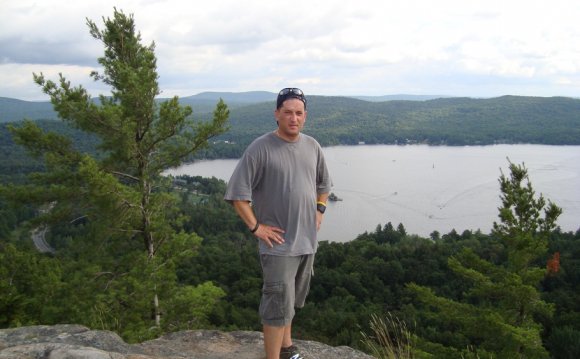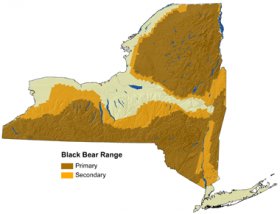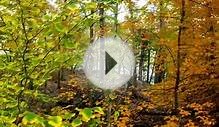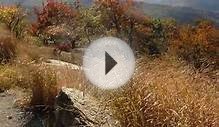
 Though rarely seen by most New Yorkers, black bears (Ursus americanus) are valued by hunters, photographers, and wildlife watchers, and many people enjoy just knowing that bears are present in New York. For many, black bears symbolize wilderness and wildness, but increasingly, bears can be found in semi-rural environments, agricultural areas and occasionally, in urban centers.
Though rarely seen by most New Yorkers, black bears (Ursus americanus) are valued by hunters, photographers, and wildlife watchers, and many people enjoy just knowing that bears are present in New York. For many, black bears symbolize wilderness and wildness, but increasingly, bears can be found in semi-rural environments, agricultural areas and occasionally, in urban centers.
New York's black bear population is currently estimated at a minimum of 6, 000-8, 000 bears in areas open to hunting, with roughly 50-60% of the bears inhabiting the Adirondack region, about 30-35% in the Catskill region and about 10-15% in the central-western region. In addition, bears are now well established in many other areas, including the Tug Hill, Hudson Valley and across the Southern Tier, and transient bears are routinely encountered throughout the Lake Ontario Plains, Mohawk Valley, and St. Lawrence Valley. With the exception of Tug Hill, these other areas include a greater proportion of agriculture or have higher human densities, making them less suitable for bears due to the higher likelihood of human-bear conflicts.
Black bears are an important and natural component of New York's ecosystem. Whether you live or recreate in the bear country, please help maintain and protect the bears, and at the same time protect yourself and your property by not feeding bears and by reducing bear attractants.
Review the Black Bear Management Plan for New York State.
Black Bear distribution in New York.
Primary range refers to areas where breeding bears were known to occur.
Secondary range includes areas with routine bear sightings.
Transient and dispersing bears may be found in all of upstate New York,
including areas generally considered unoccupied by bears.
Black bears are large - They have erect, rounded ears; a long, narrow, brown muzzle; and a short tail. An average adult male weighs about 300 pounds while females average about 170 pounds.
Black bears can remain dormant for up to 5 months in winter.
Bears eat nearly anything - They are omnivorous; eating grasses, berries, fruit, nuts, seeds, insects, grubs, and carrion, as well as human sources of food like corn, honey, bird seed, trash, and pet food when available.
Bears are curious - They spend a great deal of time exploring for food, and this can bring them close to humans.
Bears are intelligent - Bears learn from experience. If an activity results in food, they will repeat that activity. If an encounter with a human is negative, they learn to avoid humans. Also if an encounter with a human doesn't result in a reward (food), they will not have any reason to have contact with humans.
- When bears learn to obtain food from humans, they can become bold and aggressive. Deliberate and intentional feeding of bears is illegal in New York (link leaves DEC website.)
Feeding bears is bad for bears - Bears' natural foraging habits and behavior can be changed. Usually solitary, bears can be concentrated in areas causing stress, injuries from physical conflicts, and the spread of diseases. Often when feeding on garbage or camper's supplies, bears will eat unhealthy materials such as soap, shaving cream, insect repellant, food packaging, etc.
Subscribe to New York Big Game
Join New York Big Game to periodically receive information about bear and deer biology, management, research, regulations and hunting in New York State.
On the "Quick Subscribe" page you will see all the topics that you can receive email updates on from DEC. Under the "Outdoor Recreational and Commercial Activities" category, check the box next to hunting and trapping.
RELATED VIDEO












